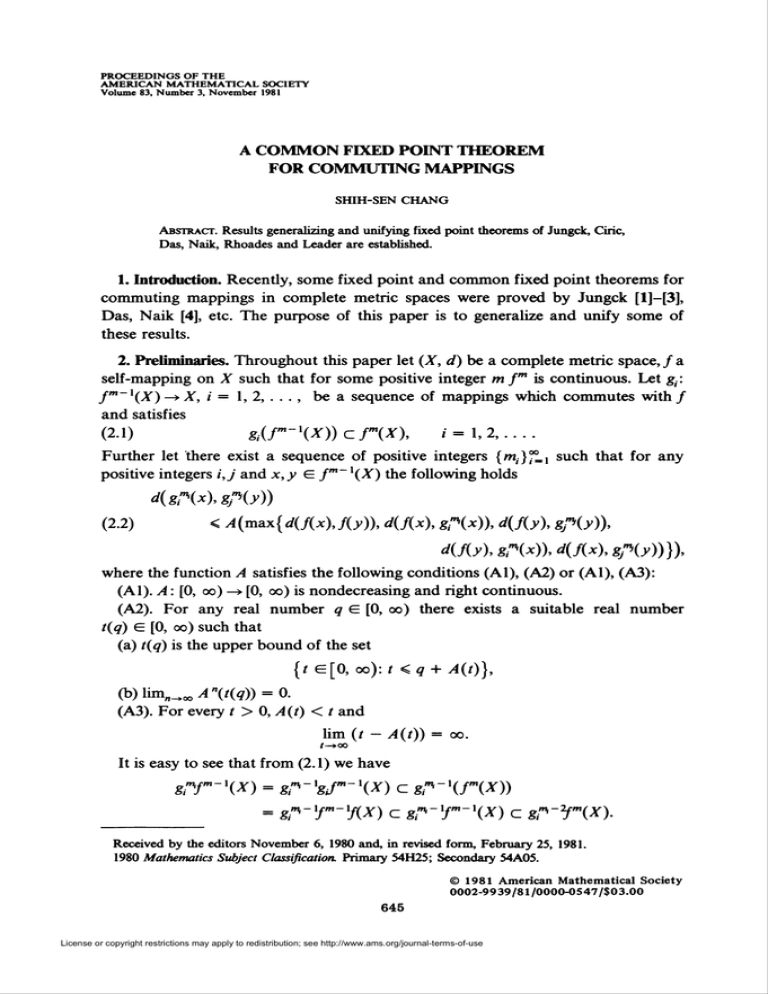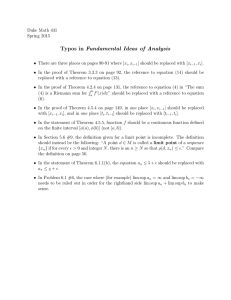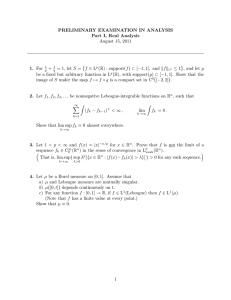gPf-i`x) = gr--xgr-\x) c gr\fm{x)) = g/^îr-`/wc grxfm-\x) c ft"*-W).
advertisement

PROCEEDINGS of the
AMERICAN MATHEMATICAL
Volume 83, Number 3, November
SOCIETY
1981
A COMMON FLXEDPOINT THEOREM
FOR COMMUTING MAPPINGS
SHIH-SEN CHANG
Abstract. Results generalizing and unifying fixed point theorems of Jungck, Ciric,
Das, Naik, Rhoades and Leader are established.
1. Introduction. Recently, some fixed point and common fixed point theorems for
commuting mappings in complete metric spaces were proved by Jungck [l]-[3],
Das, Naik [4], etc. The purpose of this paper is to generalize and unify some of
these results.
2. Preliminaries. Throughout this paper let (A, d) be a complete metric space, / a
self-mapping on X such that for some positive integer m f" is continuous. Let g¡ :
f"~x(X)—>X, i = 1, 2, . . . , be a sequence of mappings which commutes with/
and satisfies
(2.1)
giUm-\X)) C fm(X),
/=1,2,....
Further let there exist a sequence of positive integers {m¡}'*Lxsuch that for any
positive integers i,j and x, y G f"~x(X) the following holds
d{gr(x),gp(y))
(2.2)
< A(max{d(f(x),f(y)), d(fix), gp(x)), d(f(y), gp(y)),
d(Ay),gr(x)),d(f(x),gp(y))}),
where the function A satisfies the following conditions (Al), (A2) or (Al), (A3):
(Al). A : [0, oo) —»[0, oo) is nondecreasing and right continuous.
(A2). For any real number q G [0, oo) there exists a suitable real number
t(q) G [0, oo) such that
(a) t(q) is the upper bound of the set
{/ G[0, oo):r <q + A(t)},
(b)lim„^xA"(t(l))
= 0.
(A3). For every t > 0, A(t) < t and
lim (t - A(t)) = oo.
/-►oo
It is easy to see that from (2.1) we have
gPf-i'x) = gr--xgr-\x) c gr\fm{x))
= g/^îr-'/w c grxfm-\x) c ft"*-W).
Received by the editors November 6, 1980 and, in revised form, February 25, 1981.
1980 Mathematics Subject Classification. Primary 54H25; Secondary 54A05.
© 1981 American
Mathematical
0002-9939/81/0000-0547/$03.00
645
License or copyright restrictions may apply to redistribution; see http://www.ams.org/journal-terms-of-use
Society
646
SHIH-SEN CHANG
Repeating this procedure it follows that
(2.3)
gKr- W) c fm(X),
i = 1,2, . . . .
Under the assumptions stated above, now we define a sequence of points {x„} as
follows.
For any x, G/m_,(A")
let x2 G f"-x(X),
guaranteed
by (2.3), be such that
gr'(*i) = Axd- Having defined x„ G fm~ X(X),let x„+, G fm~X(X) be such that
Sn^ixJ = fix„+x),
«=1,2,....
Let
(2-4)
yn = gP(x„) = f(xn+,),
«-1,2,....
Now we prove the following lemma.
Lemma 1. Let A satisfy conditions (Al) and (A2). Then the sequence {y„}™-x
defined by (2.4) is a Cauchy sequence in X.
Proof. Indeed, for any positive integers i,j we have
d(yi,yJ) = d(gr(xi),gp(xJ))
< ^(max{4/(x,.),/(x,)),
d(f(X¡), &"•(*,■)),
d(fiXj), gp(Xj)),
d(fixj), gKxJ), d(f(X¡),gp(xj))})
< A(max{d(yi_x,yj_x),
d(yi_x,yi), d(yj_x,yj),
d(yJ-i,yi),d(yi_x,yj)}).
Thus by the assumption (Al), for any positive integers m, n (m < n), we have
(2.5)
sup
d(yi,yJ)<A(
m<ij<n
sup
d(yi,yJ)).
Vm-1</V<n
However
(2.6)
sup
d(y(,yj) < d(yx,y2) +
l<ij<n
sup
d(yi,yJ).
2<iJ<n
Taking m = 2 in (2.5), it follows from (2.6) that
(2.7)
sup
d(yi,yj) <d(yx,y2)
\<ij<n
+ a(
sup
d(yi,yJ)\.
yl<iJ<n
'
Letting the real number q = d(yx,y2) and using condition (A2) it follows from (2.7)
that there exists a real number t(q) G [0, oo) such that
(2-8)
sup ky„yj) < t(q).
KiJ<n
Take m = 2 in (2.5) again, and consider (2.8). Then we have
(2.9)
sup
d(y¡,yj)<A(t(q)).
2oy<«
Taking m = 3 in (2.5) and using (2.9) it follows that
(2.10)
sup
d(yi,yJ)<A2(t(q)).
3<iJ<n
License or copyright restrictions may apply to redistribution; see http://www.ams.org/journal-terms-of-use
COMMON FIXED POINT THEOREM FOR COMUTING MAPPINGS
647
Repeating this procedure, for any positive integers m, n (m < n) we obtain
(2.11)
sup
d(yi,yj)<Am-x(t(q)).
m < ij < n
Letting m -» oo (hence n -* oo) in (2.11), from condition (A2) we obtain
0<
lim
sup
m<i,y
d(y,,yi) < lim Am-X(t(q)) = 0.
<n
This shows that { v,} is a Cauchy sequence in A.
Lemma 2. Lei .4 satisfy the conditions (Al) an*/ (A3). 77ie7i
(i)for every t > 0 we have
lim ^"(/) = 0;
(ii) for any sequence {/„} of nonnegative real numbers satisfying the following
condition
'*+i<^(0.
we have lim,^^
«=1,2,...,
tn = 0.
Remark 1. Lemma 2(i) was essentially obtained by Singh and Meade [5]. We
include the proof for completeness.
Proof of Lemma 2. (i) For every / > 0, (A3) yields A(t) < t. Repeating this
procedure, we obtain
A"(t)<A"-x(t)<
■ ■■ <A(t)<t.
By the right continuity of A it follows that
lim A"(t)=
v
n-*co
lim A(A"-\t))
v
n-»oo
= a(V n-»oo
lim An-X(tj)./
Put v = lim,,.,^ A"(t). From the preceding relation we obtain v = A(v). If u # 0,
then it follows from (A3) that v = A(v) < v. This is a contradiction. Hence v = 0,
i.e. linin-»oo^ A "(t)
V / = 0.
(ii) From the condition of Lemma 2, it is easy to see
'n+i<^(0<^2('n-.)<
•••
<A"(tx).
Letting « -» oo and using the conclusion (i) of Lemma 2, we obtain
n—>oo
n—*oo
This completes the proof of Lemma 2.
From Lemma 2 we can prove the following lemma.
Lemma 3. Let A satisfy conditions (Al) and (A3). 77ien the sequence {y„}^x
defined by (2.4) is also a Cauchy sequence in X.
Proof. By the preceding inequality (2.7) we can prove that
hm
sup
d(y¡,yj) = sup d(y¡, v,) < oo.
License or copyright restrictions may apply to redistribution; see http://www.ams.org/journal-terms-of-use
648
SHIH-SEN CHANG
Suppose this is not the case, therefore
lim
sup
d(y¡,y)
d(y»y)-A(
sup
"^°°
K,y<„
J
= oo.
It follows from (A3) and (2.7) that
00 =
=
lim I
sup
d(yi,y))\
< d(yx,y2).
This is a contradiction. This contradiction implies that
lim
n—»oo
sup
, ...
. ~
d(y¡,y)
= sup d(yt,y)
J
1 <ij<n
. .-
IJ>1
■
J
< oo.
Now we define a decreasing sequence of nonnegative real numbers
(2.11)
tm = sup d(yt,yj),
m = 1,2,-
ij>m
From (2.5), we obtain
tm<A(tm_x),
m = 2,3,-
By Lemma 2(ii) this shows tm —»0 (m —>oo), i.e.
1-
hm
m^°°
Jl
\
sup d(yi,yj)
= r>
0.
i,j>m
J
Thus we have proved {y„}^x is a Cauchy sequence in X.
This completes the proof of Lemma 3.
3. Main results. We now formulate the main results of this paper as follows:
Theorem 1. Let (X, d) be a complete metric space, fa self-mapping on X such that
for some positive integer m f" is continuous. Let {g¡}fLx: /m_1(A')—» X be a
sequence of mappings such that (2.1) is satisfied, and suppose g¡ commutes with f,
i = 1, 2, ... . Further suppose there exists a sequence of positive integers {m¡}f>_x
such that for any positive integers i,j and any x,y G/m_1(A) (2.2) holds, where the
function A appearing in (2.2) satisfies the conditions (Al), (A2) or (Al), (A3). Then f
and g¡, i = 1, 2, ... , have a unique common fixed point fiy „), where y + G X is the
limit of the sequence { v„}^Li defined by (2.4).
Proof. Since A satisfies conditions (Al), (A2) (or (Al), (A3)), from Lemma 1 (or
Lemma 3) the sequence {y„}T-\ defined by (2.4) is a Cauchy sequence in A*.
Suppose it converges to some point y » in A. By the continuity of f", {/m(y„)}
converges to/m(y%).
However by (2.4)
(3.1)
g?{fm-\yn-ù)
= g^(fm(xn))
= fm(gP-(xn)) =fm(y„),
and this implies
(3.2)
lim g^{r-\yn-x))
= Jim f"(yn) = f»(y,).
License or copyright restrictions may apply to redistribution; see http://www.ams.org/journal-terms-of-use
COMMON FIXED POINT THEOREM FOR COMUTING MAPPINGS
649
Further, for any positive integer /', i = 1,2, ... , we obtain from (3.1) that
d(fm(yn),gp{r-l(y*)))
= d(gSfm-\yn-^gr(fm-1(y,)))
< A(max{d(r(y„_x),f"{y,)),
d{f"(y„_x), g?{fm-\yn-X))),
d(r(y,), fti/-1^,))), d(r(y,), «."Kr-'c^-i))).
(3.3)
d(r(yn_x),gp(r-x(y,)))})
< A(max{d(r(yn_x),r(yj),
d(r(yn_x),fm(yn)),
d(r(y*), r(r-'(/t))),
d(r(y,),r(yn)),
^r^-.uir-'W))})Since
lim fm(yn)=r(ym),
n—»oo
and
lim gp(r-x(yn_x))=r(y,),
then for any e > 0 there exists a positive integer «0 such that for « > n0 we have
d(r(y-i)Jm(y*))<j,
d(gHfm-\yn-x))Jm{y*))
<§•
Hence, for « > «0, we have
< /l(max{ |,
e, ¿(/"(.y,),
&-*(/"" '(>>*)))> |,
5t(</WílrW)|)
< ¿(e
+ ¿(/-(y,),
g^(/m-'(>-*)))).
First, letting « -» oo in the left side of (3.4) it follows that
d{r(y.), gp(r-l(y.))) < a(s + d(r{y.), gr{r-l{y.)))).
Next letting e \ 0 in the right side of the preceding inequality and invoking the
right continuity of A we have
d(r(y,),gr(r-\y.))) <¿(¿(/"M. sc(r~\y.)))).
By (A3) this shows
(3.5)
f"(y,) = gP(f"-x(y*)),
i = 1,2,....
License or copyright restrictions may apply to redistribution; see http://www.ams.org/journal-terms-of-use
650
SHIH-SEN CHANG
Therefore from (3.5) we obtain
d(gp(rM),r(y.))
= d(gp(r(y,),gp(r-x(y,)))
< A(max{d(r+X{y.),r(y,)),
¿(/m+1(y,),/m+'(>»))>
d{fm(yt),r{y,)), d(r{y,), gPfm{y.)),
d{r+x(y,),r(y.))})
= A(d(gPr{y,),r{y,))).
By (A3), this implies that
(3.6)
gr{r{y*)) = r{y*),
Now we prove/m(y„)
/ = 1,2,....
is the unique common fixed point of/and
g,, i = 1, 2, ...
.
Indeed, in view of (3.5) and (3.6) we have
(3.7)
f(r(y.))
=ß[gr{/m-1(y,)))
On the other hand, for any /, / = 1,2,...,
= gPfm{y*)= r(y0).
from (3.6) and (3.7) we have
d{r(ym),gf"(y*))- d{gpr{y.),gr>g{r(y.)))
< A{max{d(r+X{yjf),f(gr{y*)),
d{fm+x(y,),fm(y,)),
d(fgjm(y,), gjm(y*)), d(fgr(y,),r(yj),
(3-8)
d(r+x(ym),gr(y,))})
= A(max{d(r(y J, g/m(.y,)), 0, 0,
d(gr(y.),r(y.)), d(r(yj, &/*•(,.»})
= A(d(r(y.),gr{y*))\
By (A3) from (3.8) we have
(3.9)
r{y.) = gr{y*\
Combining (3.7) with (3.9), we obtain/m(y+)
/ = 1,2, . . . .
is a common fixed point of/and
g¡,
i = 1, 2, . . . .
To prove f"(y^)
is the unique common fixed point of / and g¡, we proceed as
follows.
Suppose there exists another common fixed point x,„ of / and g¡, i = 1, 2, ...,
such that
License or copyright restrictions may apply to redistribution; see http://www.ams.org/journal-terms-of-use
COMMON FIXED POINT THEOREM FOR COMUTING MAPPINGS
651
Consequently
d(x.,r(y.)) = d(gr{x,),gpr{y,))
< A(max{d(f{x.),r+X(y,)),
d(f(x,), »"*(*.)),
d{fm+x(y.),gpr(y.)),
d{fm+l(y,), gP{x,)), d(f{x,), gp(r(y,)))})
= A(max{d(x„fm(y,)),
0, 0, d(fm(y,), xj, d(x„r{yj)})
= A(d(x„r(x,))).
It implies x, = f"(ym).
This completes the proof of Theorem 1.
From Theorem 1 we can easily deduce the following corollary.
Corollary.
Let (A, d) be a complete metric space,
that for some positive integer m, f" is continuous. Let
sequence of mappings such that (2.1) is satisfied, and
i = 1, 2, ... . Further suppose there exists a sequence
such that for any positive integer i,j and any x, y G f"~
f a self-mapping on X such
{g¡}T-v f"~x(X) —>X be a
suppose g, commutes with f
of positive integers {wt,}?!,
'(A) the following holds:
d(gr(x), gP(y)) < k max{d(f(x),f(y)), d(f(x), g,"*(x)),d(f(y), gp(y)),
d(Ay),gP(x)),d(f(x),gp(y))},
where k is a constant: 0 < k < 1.
Then the conclusion of Theorem 1 still holds.
Proof. Taking A(t) = kt, t > 0, it is easy to see that A(t) satisfies the assumptions (Al), (A2), (A3). Therefore the conclusion of the Corollary follows from the
theorem.
Remark 2. The results of Das and Naik [4, Theorem 2.1, Theorem 3.1, Theorem
3.2 and Theorem 4.1], Ciric [6, Theorem 1 and Theorem 2], Jungck [3], Rhoades [7,
Theorem 23] are all special cases of our Corollary.
In a sense, the theorem in this paper is also a generalization and improvement of
Cheh-chih Yen [8], Murakami and Cheh-chih Yen [9] and Leader [10].
References
1. G. Jungck, A common fixed point theorem for commutting maps on L-spaces, Math. Japon.
25
(1980),81-85.
2. _,
Periodic and fixed points, and commuting mappings, Proc. Amer. Math. Soc. 76 (1979),
333-338.
3._,
Commutingmappingsand fixed points, Amer. Math. Monthly 83 (1976), 261-263.
4. K. M. Das and K. Viswanatha Naik, Common fixed point theorems for commuting maps on a metric
space, Proc. Amer. Math. Soc. 77 (1979), 369-374.
5. S. P. Singh and B. A. Meade, On commonfixed point theorems, Bull. Austral. Math. Soc. 16 (1977),
49-53.
License or copyright restrictions may apply to redistribution; see http://www.ams.org/journal-terms-of-use
652
SHIH-SEN CHANG
6. B. Ciric, A generalization of Banach's contraction principle, Proc. Amer. Math. Soc. 45 (1974),
267-273.
7. B. E. Rhoades, Comparison of various definitions of contractive mappings, Trans. Amer. Math. Soc.
226 (1977),256-290.
8. Cheh-chih Yen, Some fixed point theorem in complete metric spaces, Math. Japon. 23 (1978), 27-31.
9. H. Murakami and Cheh-chih Yen, Fixed point theorems in complete metric spaces, Math. Japon.
23 (1978),77-83.
10. S. Leader, Fixed points for general contractions in metric spaces, Math. Japon. 24 (1979), 17-24.
Department
of Mathematics,
Sichuan University, Chengdu, Sichuan, 610064, People's Repub-
lic of China
License or copyright restrictions may apply to redistribution; see http://www.ams.org/journal-terms-of-use




